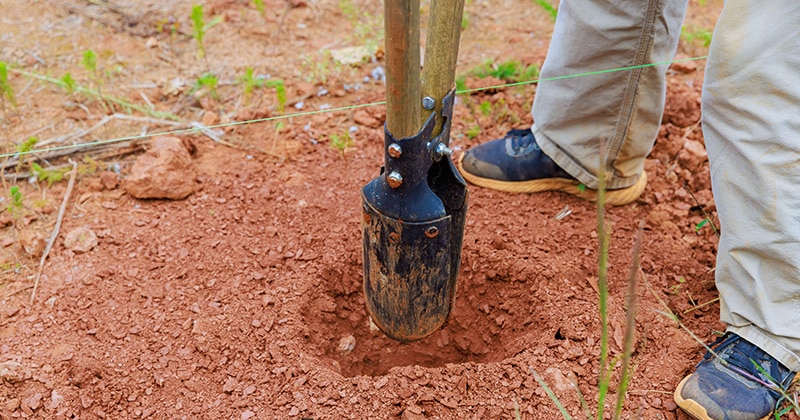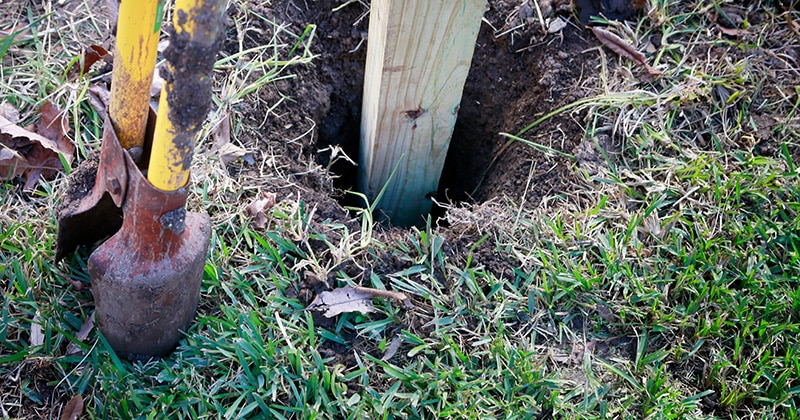The Top 6 Fence Post Hole Shovels
If you install fencing as a professional service, having the right fence post hole shovel is vital. Read our recommendations for this tool so you can find the best one for your business.

Staff Contributor
If you install fencing as a professional service, having the right fence post hole shovel is vital. Read our recommendations for this tool so you can find the best one for your business.
Learn what to look for in a post hole digger. And get expert tips you can use right away when you start shopping for your own fence post hole digger.
Consider this “Fence Post Hole Shovel 101” for home service providers.
The Importance of Quality Fence Post Hole Shovels
Do you own a fencing business? Are you a general contractor or landscaper who installs fencing? Your clients have no doubt invested thousands in their yard. So, you want to do the best job you possibly can.
That starts with having the right equipment for every project. Fence installation is one of those jobs that requires very specific tools.
Without the correct equipment, you could run into a laundry list of problems:
- Your workers are angry and unmotivated to do a good job.
- You can’t complete the job as promised to the customer.
- The job takes longer than you promised the client.
- Slow progress holds up other teams working on the property.
- The finished product looks like a bad do-it-yourself job.
- The fence is unstable, which makes it impractical or even dangerous.
Let’s look at some of these potential negative consequences for a moment.
Problems with Workers and Colleagues
If you give your workers the wrong tools for a job, it’s not going to sit well with them. These days, contractors in some parts of the country are struggling to find and retain workers. If you find good employees, you don’t want to lose them because of shoddy equipment.
What if you keep other contractors from completing their tasks on time? For instance, a landscaper may be waiting for you, the contractor, to finish the fence to put in flower beds. If you make them late, they can’t keep up their end of the project schedule.
This will not only make the client upset. It will keep them from referring you for other jobs.
Total revenue in the fencing industry rose 1.4% between 2019 and 2024. That’s a sign the business is getting more competitive, and small companies need to up their game.
Taking Too Long to Finish a Job
Even if it’s just you working on a project, the property owner expects it to be done on time. Maybe they have a cookout or a party scheduled, and they’re anticipating enjoying their new fence.
An unhappy client is what every fencing business and contractor wants to avoid. They may leave bad reviews online, which keeps new customers from hiring you. Or they may not refer you to friends or family, which could cost you a major source of business.
Did you know that 92% of consumers trust word-of-mouth referrals over conventional advertising? If you’re a small fencing business or contractor, you need those recommendations.
Poor Aesthetics Upon Completion
Put a fence in wrong and people will notice! It could look sloppy, or too much of the yard might have been dug up by mistake.
The client will surely be dissatisfied. But it could catch the eye of other potential clients too, like neighbors or passing real estate agents.
Liability for an Improperly Done Project
Of course, the worst issue with a fence project gone wrong is liability. Fences are heavy and dangerous when they’re unstable.
If a fence you put in isn’t anchored properly, it could topple and injure people. You could be faced with a large insurance claim or lawsuit that eats up your time and money.
Therefore, your best course of action is to find the proper tools for the installation. The first one you’ll need is a fence post hole shovel to set up the fence anchor in the ground.
When you use the right fence post hole shovel, your job will be completed safely and efficiently. You’ll reap the benefits of that with happy clients and more business down the line.

Overview of Top Fence Post Hole Shovels
Before you go shopping for a fence post hole shovel, it’s important to understand the different types of shovels on the market. These are also often referred to as “post hole diggers.”
It’s also vital to put together a list of criteria for this kind of tool. That can serve as a checklist as you evaluate different models. Ideally, you want the post hole shovel that ticks as many boxes on that list as possible.
Why Not Use a Regular Garden Spade or Shovel?
It’s important to note that you should not use a conventional shovel or garden spade to dig a hole for a fence post. You’ll wind up with a hole that’s too wide and not shaped properly for a post.
An overly wide hole won’t hold the post properly. If you try to repack dirt into the hole to make it narrower, it won’t be solid enough.
If you leave the hole as-is, you’ll wind up using far too much concrete to anchor your post. This is wasteful and will leave a noticeable ring around every post where there is no grass or landscaping.
Additionally, starting a hole is much easier with a dedicated fence post hole shovel. Being able to attack the ground vertically will get your hole begun faster than if you come at it from the side with a spade.
Some fencing experts still use a small fence post spade together with a ramming bar for digging holes. However, as you’ll see in the recommendations below, there are better alternatives these days. The newer options require less muscle and coordination and generally get the job done quicker.
Why Not an Auger?
If you’ve looked online for fence post hole shovels, you’ve probably seen augers mixed in with your findings. Augers are typically gas or electric powered and have corkscrew-like blades that spin down into the earth to dig a hole. You may have seen ice fishermen using similar manual versions to cut a hole in the ice to fish.
Augers (aka earth augers) are more powerful than traditional post hole diggers. You may find if you do a lot of fence work or have exceptionally heavy soil, you need one. But they do have several negatives:
- Augers require a source of electrical power or gasoline.
- They’re noisy, which can be disruptive to clients and neighbors.
- You may need two people to operate a larger model.
- They’re about three times or more the cost of a shovel.
- Augers have more bells and whistles that can break or malfunction.
- This option may not be an effective or safe choice in rocky ground.
Types of Fence Post Hole Shovels
There’s not a ton of variety in the design of fence post hole shovels. The classic “clamshell” design was originally patented in 1907.
This type of shovel consists of two parallel handles joined at the bottom. Beneath the handles are the “jaws” that dig into the ground, pinch together, and remove soil. The hinge where the handles meet the jaws allows for the handles to open and close as needed to move dirt.
The biggest differences between most fence post hole shovels are their materials. The handles can vary, being made of:
- Wood
- Fiberglass
- Steel
Also, the shape of the blades of the jaws can vary by model. Some are rounded, some are pointed, and some have sharper edges than others.
There are a couple of new fence post hole shovels available that are different from the classic design. We’ll talk about those in our reviews below and why you may want to strongly consider them for your business.
Factors to Consider When Buying a Fence Post Hole Shovel
Post hole shovels may all look pretty much the same at first glance. But there are subtle differences between them. There are a few things you should think about as you shop for a shovel.
Effectiveness
First, there’s effectiveness. You want a fence post hole shovel that can dig as deep and as wide as you need it to. That means having the right weight, sturdiness, and edge for the job.
With a post hole shovel, you should consider both the downstroke of the dig as well as pulling the shovel back out of the hole. While lighter shovels may feel better initially, they may not have the heft you need once you go a foot or more below the surface.
In sand or very loamy soils, you may find that a lighter shovel, with wooden handles, is sufficient. But in thick clay or hard-packed soils, a heavier post hole shovel with steel handles will probably serve you better. Your soil type is largely determined by your geographic location in the US.
If you’re in a colder climate, you’ll likely want a heavier post hole shovel. Why? You’ll need to dig deeper to get below the frost line. While 24 inches may be deep enough in Florida, you’ll want to dig to at least 30 inches in Minnesota.
Some handles offer more flex too, particularly wooden ones. Some folks like this feel. And yet others find it impairs the effectiveness of their digging.
Comfort
You may have noticed that effectiveness sometimes overlaps with comfort. You want to find the sweet spot between a fence post hole shovel that has adequate strength and is manageable by you or your crew.
Sometimes, wear and tear over time can affect the comfort of a shovel. For instance, fiberglass handles can get dings that allow fiberglass shreds to emerge. That can cause a nasty wound.
Because they have less flex, metal-handled post hole shovels can bend at the jaws on the bottom. This can make the shovel uneven eventually and awkward to use as a result.
A shovel that’s out of balance can affect ergonomics, which is a subcategory of comfort. This is the way a tool affects your body when used over time. Poor ergonomics can result in muscle strain, pain, and repetitive use injuries.
Safety
Next, you can think about safety. Operating a post hole shovel creates opportunities for pinched fingers, splinters, and blisters. You want the safest shovel available.
Conductivity
Finally, consider the conductivity of the shovel. Fiberglass handles are non-conductive, making them ideal for using around utilities. (Pro tip: Always call to locate or confirm power lines before you dig.)

The Top 6 Fence Post Hole Shovels
We used effectiveness, comfort, and safety in evaluating the recommended fence post hole shovels below. We also included these factors in our reviews:
- Cost effectiveness and value for the price
- Brand reputation with professionals
- Durability and expected lifespan of the tool
- Unique extras that influence performance
AMES 2701600 Post Hole Digger with Hardwood Measurement Handle
This 58-inch fence post hole shovel weighs 8.9 pounds. Its slightly lighter weight comes from the wooden handles that feature oversized cushion grips.
The blades are made of durable steel alloy. But what users like most about this model is the measuring stick printed on the handle to make determining hole depth quick and easy.
As mentioned above, wooden handles can have more flexion than some professionals like, making that a negative. Also, there is the possibility of splinters as the wood wears.
Razor-Back 48-Inch Fiberglass Handle Post Hole Digger
If you prefer the insulating properties of fiberglass, this model from Razor-Back is a popular choice.
At 11.5 inches, the steel blades are about 2 inches longer than the Ames model above. Like the Ames, it has cushion grip handles for worker comfort. The unit measures nearly 5 feet in all, blades included.
Some reviewers reported that the handles broke sooner than expected. It may be a better option if you only do occasional post hole digging for contracting or landscaping. If you’re a professional fencer, the digger may not hold up to rigorous use.
Truper Post Hole Digger STL 48
For a steel-handled shovel, the Truper gets raves from many users. Like the Ames, it has a measuring stick on one handle for easy post hole sizing.
This fence post hole shovel was designed for professional and agricultural use. So, you know it was made to withstand heavy utilization. Said one reviewer, “As a fence contractor, I would buy more.”
Buyers like the lifetime-rated handles, which also have cushion grips like the previous two models.
At 9.5 pounds, it’s a little heavier than a wood-handled version. Some people found it too heavy and encountered customer service issues when trying to return it.
Fiskars 60-Inch Steel Posthole Digger
This shovel is a little different from the traditional diggers mentioned previously. Made by Fiskars, known for their scissors and shears, it features a scissor-like design.
The 16-gauge powder-coated steel alloy handles are offset. This both protects the knuckles and allows for deeper, more powerful digging. Users like how it cuts efficiently through the ground and how long-lasting the item is. The manufacturer does offer a lifetime warranty, though, should a problem occur.
One downside to this shovel is its price tag. It’s about twice the cost of a wooden- or fiberglass-handled digger. Another is its weight: 10.45 pounds.
Simpole Fence Post Hole Digger
Simpole also uses a revolutionary design for their fence post hole digger, which the company has patented. The handles have an optional retractable mechanism. Use them like you would a regular digger. Or push a button on each handle and release the inner element to function as a ramming rod.
This shovel has multiple features that users appreciate:
- Built-in measuring stick
- Locking handles for easy storage
- Cushion grips on the handles
But if you thought the Fiskars digger was pricey, brace yourself for the Simpole. At nearly $200, this is more of an investment. You want to be sure the unique handle function is worth the money.
Nu Boston Digger
Another expensive but effective fence post hole shovel is the Nu Boston Digger. This model had This Old House viewers writing and calling to find out more about it.
Although it’s meant for looser soil, it is designed for commercial use. It uses a lever-action scoop for maximum digging efficiency. This model only has one wooden handle, with a steel handle alongside to operate the scoop.
Users like it for lifting out rocks and cutting through roots. Other pluses include:
- Ability to dig up to 44-inch holes
- Powder-coated steel components
- Cutting blade tempered for extra strength
At over $200, the Boston Digger is, like the Simpole, a business investment. Also, because it’s not configured like a regular fence post hole shovel, it may take longer to get up to speed with using it.
Top Takeaway Tips for Selecting a Fence Post Hole Shovel
-
Do you work with a crew? If so, ask them what they like and don’t like about post hole shovels they’ve used before. What would make their job easier and more efficient?
-
Inquire about return policies and warranties wherever you buy a shovel. Will they take the item back if it’s not up to your standards? How quickly can you get a replacement? You don’t want to be left unable to work while waiting for a solution, or you’ll lose money.
-
Even the best fence post hole shovels can be hard on the hands. Make sure your workers are outfitted with suitable gloves for protection.
-
Don’t let 10 or 20 dollars stand between you and the best tool for your projects. The savings won’t be worth it if you don’t get the results you want. And your crew won’t be happy either.
-
Where would you like to see your landscaping or contracting business in the next year or two? Purchase your equipment accordingly. Buy enough shovels to handle an increase in workload or think about whether an auger would be a better investment. Your clients will appreciate your efficiency, and you’ll stay ahead of the competition.
Alison began her career as a storyteller crafting a variety of engaging content. She has experience in creative writing, marketing, social media, and education. When she's not writing, she's spending time with her family and dog.

Business Solutions For Field Service Pros
EverPro offers specialized solutions designed for home and field service professionals. We’ve got the business tools to help you get the job done.



